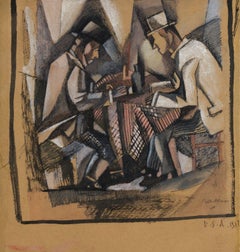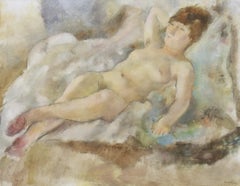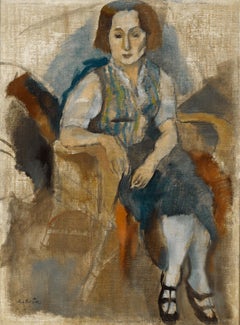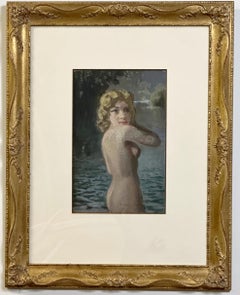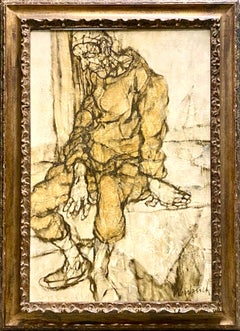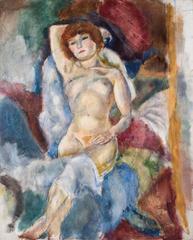Jules Pascin Paintings
to
3
2
2
3
2
3
2
Overall Height
to
Overall Width
to
1
1
1
1
5
4
4
2
2
1
1
5
1
1
1
22
904
676
666
610
4
2
2
2
2
Artist: Jules Pascin
Gouache Painting Jules Pascin Hand Signed Woman in Boudoir German Expressionism
By Jules Pascin
Located in Surfside, FL
Genre: German Expressionist
Subject: Woman
Medium: gouache paint
Surface: Paper board
This is hand signed lower right.
Framed it measures 17.25 X 15.5, sheet 12 X 10
This came from a Jewish estate. there was no additional paperwork or provenance.
Julius Mordecai Pincas (March 31, 1885 – June 5, 1930), known as Pascin Jules...
Category
Early 20th Century Expressionist Jules Pascin Paintings
Materials
Paper, Cardboard, Gouache
Les buveurs
By Jules Pascin
Located in London, GB
Jules Pascin was a larger-than-life artist who defied easy categorisation. The Bulgarian-born, Viennese-trained artist moved to Paris in 1905 and quickly fell into influential circle...
Category
1910s Jules Pascin Paintings
Materials
Ink, Pen, Gouache, Watercolor, Paper
Rebecca Couchée by JULES PASCIN - School of Paris, Nude Painting, Figurative Art
By Jules Pascin
Located in London, GB
*UK BUYERS WILL PAY AN ADDITIONAL 5% IMPORT DUTY ON TOP OF THE ABOVE PRICE
Rebecca Couchée by JULES PASCIN (1885-1930)
Oil over pencil on canvas
73.1 x 91.8 cm (28 ¾ x 36 ⅛ inches)
Signed lower right, Pascin
Executed in 1927, Boulevard de Clichy, Paris
Provenance
Collection Marcel Bernheim, Palais des Beaux-Arts de Bruxelles, acquired from the artist, 1928
Pierre Blum, Paris, acquired from the above, 1952
Perls Galleries, New York, no. 13565
Private collection, Osaka
Sotheby’s, New York, 14th May 1998
Peter Findlay Gallery Inc., New York
Private collection, USA, acquired from the above, June 2011
Literature
Luis Seoane...
Category
1920s Post-Impressionist Jules Pascin Paintings
Materials
Oil, Canvas, Pencil
Femme aux Souliers Noir (Woman in Black Shoes)
By Jules Pascin
Located in New Orleans, LA
This intimate portrait was composed by the Bulgarian-born French Expressionist painter Jules Pascin. Known as the "Prince of Montparnasse," Pascin made a name for himself throughout ...
Category
Early 20th Century Modern Jules Pascin Paintings
Materials
Oil, Canvas
A Group of Prostitutes
By Jules Pascin
Located in London, GB
JULES PASCIN 1885-1930
Vidin, Bulgaria 1885-1930 Paris ( Bulgarian / French / American)
Title: A Group of Prostitutes
Technique:Original Hand Signed Sanguine Crayon Drawing on Chi...
Category
1970s Impressionist Jules Pascin Paintings
Materials
Crayon
Related Items
La Baloneuse Framed Signed Painting
By Emile Wegelin
Located in Rochester Hills, MI
Emile Wegelin: Capturing the Essence of Nature.
Painting on Hardboard
Size-Width Size-Height: 32'' x 25''
Signed in Ink
Emile Wegelin (1875-1962) devoted his life to paintin...
Category
1950s Post-Impressionist Jules Pascin Paintings
Materials
Acrylic
Large French Figurative Expressionist Oil Painting Seated Figure Claude Weisbuch
By Claude Weisbuch
Located in Surfside, FL
WEISBUCH, Claude.
Oil on Canvas
Framed size: 39” H x 28” W
Canvas, without frame: 32” high x 21 ¼” wide.
Carved wooden frame with antique gold-leaf finish
Claude Weisbuch, 1927-2014 French painter, draftsman and engraver. He studied at the Ecole des Beaux-Arts (School of Fine Arts) in Nancy and upon graduation became a professor of engraving at the Ecole des Beaux-Arts de of St. Etienne. His first solo exhibition was in 1957.
In 1968 , he became a full member of the Society of French Painters-Engravers .
In 1997 he was awarded the Legion of Honor
His work is essentially devoted to engraving, by which he likes to translate, thanks to the line, the life, movement and character of his characters: Punchinels, harlequins, musicians or equestrian scenes. He practices various techniques ( lithography, drypoint etching etc.) that he puts to use in the illustration of bibliophile books.
Claude Weisbuch is also a painter and draftsman. His favorite colors are ochres, browns and whites, with which he seeks to introduce the effects of light by compositions where the line and finesse of the drawing preserve the life found in his engravings.
His precise and dynamic line delivers a moving and swirling work on themes he loves: theater, opera, equestrian, musicians, card players, Kabuki dancers and many portraits.
His works have the appearance of unfinished sketches mixing few colors but a great vivacity of the line. He illustrated many limited edition signed fine art books. Alon with Christo, Arman and Cesar he is considered among the great post war French artists of the last generation.
Exhibitions
1957: Saint Placide Gallery, paintings and engravings
1958: Galerie de Presbourg, Paris, paintings - Saint Placide Gallery, Paris, paintings - Galerie des Arts, Nancy, etchings
1960: Galerie Hervé, "Extraordinary Pantomimes", Paris, paintings
1961: Salon of the young painting and painters witnesses of their time
1962: O'Hanna Gallery, London , paintings
1963: Galerie Hervé, "Portrait Of Man", Paris, Paintings - Nichido Gallery, Tokyo, Paintings
1965: Hervé Gallery, "100 Drawings", Paris Dresdener Gallery, Toronto, paintings
1966: Dantesca Gallery, Turin , paintings, engravings, drawings
1968: New Vision Gallery, Paris, engravings
1969: Galerie Hervé, Paris, paintings - Galerie Reflets, Brussels , prints, paintings - Galerie Dresder, Montreal , paintings
1970: Taménaga Gallery, Tokyo, paintings - Sagot Gallery - The Garrec, Paris, etchings - Museum of Modern Art of the City of Paris ARC, Paris, prints 5
1971: War Gallery, Avignon , etchings Biennial of Engraving, Epinal
1972: Dantesca Gallery, Turin Festival, Sarlat , paintings
1973: Wayss Gallery, Nancy , paintings, engravings, drawings Auguste Comte Gallery, Lyon , paintings, engravings, drawings Taménaga Gallery, Tokyo, paintings - New Vision Gallery, "Homage to Rembrandt", Paris, etchings
1974: Esthetika Gallery, Kortrijk, engravings - Galerie Hervé Odermatt, Paris, paintings Ésthetika Gallery, Kurne, prints - Galerie Wayss, Nancy, engravings, drawings, pastels Dietesheim Gallery, Neuchâtel , engravings - Grafikhuset Gallery, Stockholm , prints, drawings
1975: Schwarzer Gallery, Vienna , engravings, paintings, drawings Fogola Gallery, Turin, drawings, pastels Sotheby-Parke Benett, Munich, engravings, drawings Hervé Odermatt Gallery, Paris, drawings Joly Gallery, Washington , engraving
1976: Taménaga Gallery, Tokyo, paintings - Wayss Gallery, Nancy, engravings, drawings - Tabula Gallery, Tübingen, engravings, drawings - New Vision Gallery, "The horse-The painter and his model", Paris, drawings, engravings
1977: Grafikhuset, Futura, Stockholm - Jivô Gallery, Vänersborg Pigalle Gallery, Norrköping Celsius Gallery, Uppsala Möbius Gallery, Gothenburg - New Vision Gallery, Jerusalem - Cultural Center of Sainte-Menehould Castle, retrospective, engravings
1978: David Barnett Gallery, Milwaukee , engravings, drawings Orangery Gallery, Cologne , engravings, drawings, pastels Grafikhuset Futura, Stockholm, paintings, drawings Les Cordeliers, Châteauroux, engravings, drawings, paintings House of Culture, Montbéliard, engravings House of Culture, Chelles , engravings, paintings, drawings
1979: L'Empreinte Gallery, Strasbourg, prints, drawings - Galerie Reflets, Brussels, prints, drawings - Galerie Bon à tirer, Los Angeles , prints, pastels
1980: Hervé Odermatt Gallery, Paris, "Calligraphy of the figure", paintings - E. Gollon Gallery, Saint-Paul-de-Vence
1981: European Biennale of Engraving, Baden-Bade Galerie The Art Shop...
Category
20th Century Modern Jules Pascin Paintings
Materials
Oil, Canvas
Untitled, Pen & Ink & Watercolor on Paper by Contemporary Artist "In Stock"
By Nandan Purkayastha
Located in Kolkata, West Bengal
Nandan Purkayastha - Untitled
Pen & Ink & Watercolor on Paper, 60 x 34 inches
Debapriyo Nandan Purkayastha was born in Assam in 1986. He studied Fa...
Category
2010s Contemporary Jules Pascin Paintings
Materials
Paper, Ink, Watercolor, Pen
"Apple tree" pastel cm. 45 x 35 ( frame cm. 60 x 70)
By Olga BOGAEVSKAJA
Located in Torino, IT
with frame is cm. 70 x 60
no frame cm. 45 x 35
Category
1980s Impressionist Jules Pascin Paintings
Materials
Pastel
"Somewhere in Paris" Oil Painting
By Suchitra Bhosle
Located in Denver, CO
Suchitra Bhosle's "Somewhere in Paris" is an original, hand made oil painting that depicts a feminine model in a translucent white shift reclining on a background of white.
About th...
Category
2010s Post-Impressionist Jules Pascin Paintings
Materials
Board, Oil
Hercules Mourning the Death of his Cupbearer Hylas
By Mark Beard
Located in New York, NY
[Hippolyte-Alexandre Michallon (1849-1930)]
Oil on canvas
Signed in red, l.l.
48 x 60 inches, canvas size
54 x 66 inches in gold leaf frame
61 x 74 x 6 inches, framed
This artwork is offered by ClampArt, located in New York City.
“By his own account, the most ambitious work of Michallon’s career was a thirty-foot canvas depicting Noah’s Ark, which he exhibited in the Salon of 1875, where it went unmentioned by the critics. Preparatory work for this elaborate composition took him frequently to the Jardin des Plantes, where he made painstaking drawings and oil sketches of the animals on view. These studies were enthusiastically remarked upon by visitors to his studio, some of whom counseled him to give up history painting altogether and pursue the less dignified but presumably more lucrative career of animal painter. Following this advice, and profiting from the tremendous vogue in 1880s Europe for all things African...
Category
21st Century and Contemporary Realist Jules Pascin Paintings
Materials
Canvas, Oil
Modernist Nude Portrait by Henri Burkhard
By Henri Burkhard
Located in Larchmont, NY
Henri Burkhard, Born in New York in 1892, began his studies at the Art Students league in New York and then pursued international studies at the Académie Julian, Acadêmie Colarissi, and Académie de la Grande Chaumière, Pariss.
Once the artist returned to New York, he began to exhibit frequently frequently at the Whitney Museum of American Art in 1926-36; the Corcoran Gallery, Art Institute of Chicago, and the Pennsylvania Academy of Fine Arts in the 1930's. Works by the artist have been handled and sold over the last hundred years at major American auction houses and dealers, such as Heritage...
Category
1930s Fauvist Jules Pascin Paintings
Materials
Oil, Wood Panel
The Abduction of the Sabine Women , a Renaissance drawing by Biagio Pupini
Located in PARIS, FR
This vigorous drawing has long been attributed to Polidoro da Caravaggio: The Abduction of the Sabine Women is one of the scenes that Polidoro depicted between 1525 and 1527 on the façade of the Milesi Palazzo in Rome. However, the proximity to another drawing inspired by this same façade, kept at the Ecole des Beaux-Arts, and to other drawings inspired by Polidoro kept at the Musée du Louvre, leads us to propose an attribution to Biagio Pupini, a Bolognese artist whose life remains barely known, despite the abundant number of drawings attributed to him.
1. Biagio Pupini, a Bolognese artist in the light of the Roman Renaissance
The early life of Biagio Pupini, an important figure of the first half of the Cinquecento in Bologna - Vasari mentions him several times - is still poorly known. Neither his date of birth (probably around 1490-1495) nor his training are known. He is said to have been a pupil of Francesco Francia (1450 - 1517) and his name appears for the first time in 1511 in a contract with the painter Bagnacavallo (c. 1484 - 1542) for the frescoes of a church in Faenza. He then collaborated with Girolamo da Carpi, at San Michele in Bosco and at the villa of Belriguardo.
He must have gone to Rome for the first time with Bagnacavallo between 1511 and 1519. There he discovered the art of Raphael, with whom he might have worked, and that of Polidoro da Caravaggio. This first visit, and those that followed, were the occasion for an intense study of ancient and modern art, as illustrated by his abundant graphic production.
Polidoro da Caravaggio had a particular influence on the technique adopted by Pupini. Executed on coloured paper, his drawings generally combine pen, brown ink and wash with abundant highlights of white gouache, as in the drawing presented here.
2. The Abduction of the Sabine Women
Our drawing is an adaptation of a fresco painted between 1525 and 1527 by Polidoro da Caravaggio on the façade of the Milesi Palace in Rome. These painted façades were very famous from the moment they were painted and inspired many artists during their stay in Rome. These frescoes are now very deteriorated and difficult to see, as the palace is in a rather narrow street.
The episode of the abduction of the Sabine women (which appears in the centre of the photo above) is a historical theme that goes back to the origins of Rome and is recounted both by Titus Livius (Ab Urbe condita I,13), by Ovid (Fasti III, 199-228) and by Plutarch (II, Romulus 14-19). After killing his twin brother Romus, Romulus populates the city of Rome by opening it up to refugees and brigands and finds himself with an excess of men. Because of their reputation, none of the inhabitants of the neighbouring cities want to give them their daughters in marriage. The Romans then decide to invite their Sabine neighbours to a great feast during which they slaughter the Sabines and kidnap their daughters.
The engraving made by Giovanni Battista Gallestruzzi (1618 - 1677) around 1656-1658 gives us a good understanding of the Polidoro fresco, allowing us to see how Biagio Pupini reworked the scene to extract this dynamic group.
With a remarkable economy of means, Biagio Pupini takes over the left-hand side of the fresco and depicts in a very dense space two main groups, each consisting of a Roman and a Sabine, completed by a group of three soldiers in the background (which seems to differ quite significantly from Polidoro's composition).
The balance of the drawing is based on a very strongly structured composition. The drawing is organised around a median vertical axis, which runs along both the elbow of the kidnapped Sabine on the left and the foot of her captor, and the two main diagonals, reinforced by four secondary diagonals. This diamond-shaped structure creates an extremely dynamic space, in which centripetal movements (the legs of the Sabine on the right, the arm of the soldier on the back at the top right) and centrifugal movements (the arm of the kidnapper on the left and the legs of the Sabine he is carrying away, the arm of the Sabine on the right) oppose each other, giving the drawing the appearance of a whirlpool around a central point of support situated slightly to the left of the navel of the kidnapper on the right.
3. Polidoro da Caravaggio, and the decorations of Roman palaces
Polidoro da Caravaggio was a paradoxical artist who entered Raphael's (1483 - 1520) workshop at a very young age, when he oversaw the Lodges in the Vatican. Most of his Roman work, which was the peak of his career, has disappeared, as he specialised in facade painting, and yet these paintings, which are eminently visible in urban spaces, have influenced generations of artists who copied them abundantly during their visits to Rome.
Polidoro Caldara was born in Caravaggio around 1495-1500 (the birthplace of Michelangelo Merisi, known as Caravaggio, who was born there in 1571), some forty kilometres east of Milan. According to Vasari, he arrived as a mason on the Vatican's construction site and joined Raphael's workshop around 1517 (at the age of eighteen according to Vasari). This integration would have allowed Polidoro to work not only on the frescoes of the Lodges, but also on some of the frescoes of the Chambers, as well as on the flat of Cardinal Bibiena in the Vatican.
After Raphael's death in 1520, Polidoro worked first with Perin del Vaga before joining forces with Maturino of Florence (1490 - 1528), whom he had also known in Raphael's workshop. Together they specialised in the painting of palace façades. They were to produce some forty façades decorated with grisaille paintings imitating antique bas-reliefs.
The Sack of Rome in 1527, during which his friend Maturino was killed, led Polidoro to flee first to Naples (where he had already stayed in 1523), then to Messina. It was while he was preparing his return to the peninsula that he was murdered by one of his assistants, Tonno Calabrese, in 1543.
In his Vite, Vasari celebrated Polidoro as the greatest façade decorator of his time, noting that "there is no flat, palace, garden or villa in Rome that does not contain a work by Polidoro". Polidoro's facade decorations, most of which have disappeared as they were displayed in the open air, constitute the most important lost chapter of Roman art of the Cinquecento. The few surviving drawings of the painter can, however, give an idea of the original appearance of his murals and show that he was an artist of remarkable and highly original genius.
4. The façade of the Milesi Palace
Giovanni Antonio Milesi, who commissioned this palace, located not far from the Tiber, north of Piazza Navona, was a native of the Bergamo area, like Polidoro, with whom he maintained close friendly ties. Executed in the last years before the Sack of Rome, around 1526-1527, the decoration of Palazzo Milesi is considered Polidoro's greatest decorative success.
An engraving by Ernesto Maccari made at the end of the nineteenth century allows us to understand the general balance of this façade, which was still well preserved at the time. The frescoes were not entirely monochrome, but alternated elements in chiaroscuro simulating marble bas-reliefs and those in ochre simulating bronze and gold vases...
Category
16th Century Old Masters Jules Pascin Paintings
Materials
Ink, Gouache, Pen
Oil Pastel and Pencil Still Life of Wine and Spirits Bottles
Located in Soquel, CA
Oil Pastel and Pencil Liquor Still Life
Oil pastel and pencil still life depicting a line up of Dutch liquor bottles and drinking glasses by Erin Pearce (American, 20th C). Liquor ...
Category
1980s American Impressionist Jules Pascin Paintings
Materials
Paper, Oil Pastel, Pencil
H 24 in W 30 in D 0.5 in
Nude oil painting, large post-impressionist sitting nude by Pio Santini
Located in AIGNAN, FR
Large vintage nude portrait oil painting of a woman sitting. This is a gorgeous, colourful and exceptional nude oil painting by Pio Santini, signed in the lower right. A young woman...
Category
1940s Post-Impressionist Jules Pascin Paintings
Materials
Oil
French Nude Female Portrait Interior Post Impressionist Signed Impasto Oil
Located in Cirencester, Gloucestershire
Nude Portrait
by Josine Vignon (French 1922-2022)
signed on front and back
oil painting on canvas, unframed
canvas: 18 x 13 inches
Colors: Beige colors, beige, brown, blue , green ...
Category
Mid-20th Century Post-Impressionist Jules Pascin Paintings
Materials
Oil, Canvas
Mid Century French Nude Painting Of A Lady Stood Posed
Located in Cirencester, Gloucestershire
Nude Lady
by Josine Vignon (French 1922-2022)
oil on thin board, unframed
board: 27 x 15 inches
good condition with some cracks shown in photos
provenance: from the artists estate, ...
Category
Mid-20th Century Post-Impressionist Jules Pascin Paintings
Materials
Oil
Previously Available Items
Nu, le Bras Levé
By Jules Pascin
Located in London, GB
Oil and pencil on canvas
72.4 x 59.1 cm (28 ½ x 23 ¼ inches)
Signed upper right, Pascin
Executed 1916
Literature
Jules Pascin: Catalogue Raisonné by Krohg, Hemin, Perls and R...
Category
Early 20th Century Expressionist Jules Pascin Paintings
Materials
Oil, Pencil
Jules Pascin paintings for sale on 1stDibs.
Find a wide variety of authentic Jules Pascin paintings available for sale on 1stDibs. You can also browse by medium to find art by Jules Pascin in paint, canvas, fabric and more. Much of the original work by this artist or collective was created during the 20th century and is mostly associated with the Post-Impressionist style. Not every interior allows for large Jules Pascin paintings, so small editions measuring 16 inches across are available. Customers who are interested in this artist might also find the work of Georges Rouault, Louis Valtat, and Charles Picart le Doux. Jules Pascin paintings prices can differ depending upon medium, time period and other attributes. On 1stDibs, the price for these items starts at $4,200 and tops out at $98,500, while the average work can sell for $59,705.

